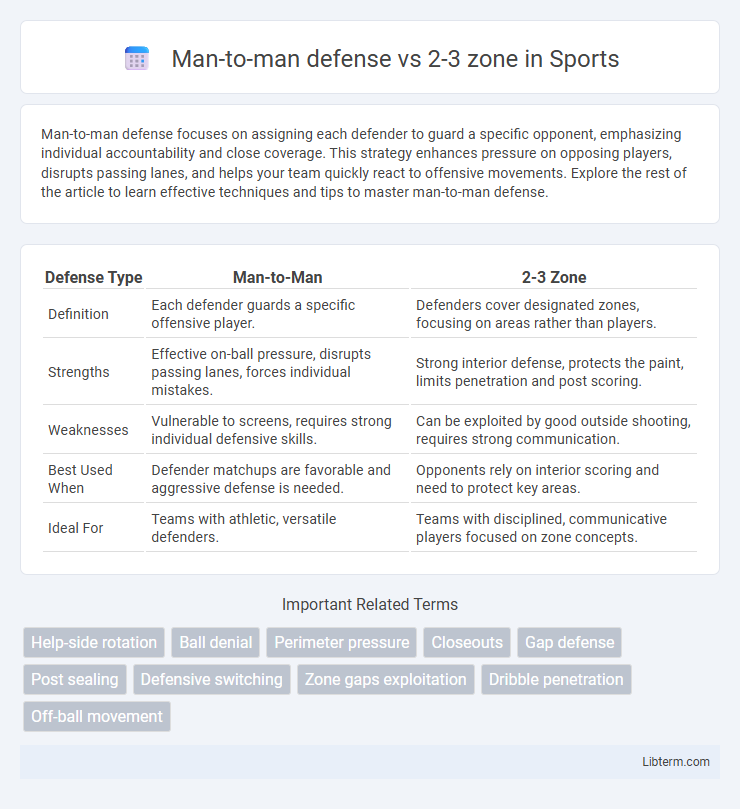Man-to-man defense focuses on assigning each defender to guard a specific opponent, emphasizing individual accountability and close coverage. This strategy enhances pressure on opposing players, disrupts passing lanes, and helps your team quickly react to offensive movements. Explore the rest of the article to learn effective techniques and tips to master man-to-man defense.
Table of Comparison
| Defense Type | Man-to-Man | 2-3 Zone |
|---|---|---|
| Definition | Each defender guards a specific offensive player. | Defenders cover designated zones, focusing on areas rather than players. |
| Strengths | Effective on-ball pressure, disrupts passing lanes, forces individual mistakes. | Strong interior defense, protects the paint, limits penetration and post scoring. |
| Weaknesses | Vulnerable to screens, requires strong individual defensive skills. | Can be exploited by good outside shooting, requires strong communication. |
| Best Used When | Defender matchups are favorable and aggressive defense is needed. | Opponents rely on interior scoring and need to protect key areas. |
| Ideal For | Teams with athletic, versatile defenders. | Teams with disciplined, communicative players focused on zone concepts. |
Introduction to Man-to-Man Defense and 2-3 Zone
Man-to-man defense assigns each player to guard a specific opponent, emphasizing individual responsibility and agility to counter offensive moves. The 2-3 zone defense positions five players in a formation covering distinct areas on the court, prioritizing spatial control and protection of the paint against drives. Both strategies demand distinct skill sets and team coordination to effectively disrupt offensive patterns and control game tempo.
Core Principles of Man-to-Man Defense
Man-to-man defense emphasizes individual accountability, with each player responsible for guarding a specific opponent, ensuring constant pressure and minimizing open shots. Core principles include maintaining proper defensive stance, effective footwork to stay between the opponent and the basket, and communication to switch or help when necessary. This scheme relies heavily on anticipation, agility, and disciplined positioning to disrupt offensive plays and force turnovers.
Key Features of the 2-3 Zone Defense
The 2-3 zone defense features a formation with two defenders positioned at the top and three players aligned along the baseline, designed to protect the paint and force outside shots. Key features include its emphasis on area coverage rather than individual assignments, which limits dribble penetration and disrupts passing lanes. The 2-3 zone requires constant communication and rotation to effectively contest perimeter shooters and secure rebounds within the designated zones.
Strengths of Man-to-Man Defense
Man-to-man defense excels in applying intense pressure on individual offensive players, disrupting their rhythm and reducing easy scoring opportunities. It allows defenders to closely contest shots, generate turnovers through tight coverage, and adapt quickly to offensive movement. This defensive scheme also enhances rebounding opportunities by assigning clear responsibilities, minimizing open lanes for opponents.
Advantages of the 2-3 Zone Defense
The 2-3 zone defense excels in protecting the paint by positioning three defenders near the basket, reducing opponents' high-percentage shots and forcing perimeter attempts. This defensive alignment conserves energy by minimizing the need for constant man-to-man tracking, allowing players to focus on intercepting passes and rebounding. Teams employing the 2-3 zone often disrupt offensive rhythm, leading to turnovers and limited penetration compared to man-to-man defense.
Weaknesses of Man-to-Man Defense
Man-to-man defense often struggles against teams with strong individual offensive players who can exploit one-on-one mismatches, leading to easy scoring opportunities. It requires high stamina and communication, as defensive breakdowns occur when players fail to effectively switch or help on screens. Additionally, man-to-man defense can be vulnerable to pick-and-roll plays and perimeter shooting, as defenders may be forced to accommodate spacing rather than aggressively contest shots.
Limitations of the 2-3 Zone Defense
The 2-3 zone defense often struggles against teams with strong outside shooters, as it leaves perimeter gaps that skilled players can exploit. Its reliance on teamwork and communication can break down under fast-paced offenses, leading to defensive breakdowns. The zone also limits individual defensive pressure, making it harder to contain versatile players who excel in one-on-one situations.
When to Use Man-to-Man vs 2-3 Zone
Man-to-man defense excels in situations requiring intense individual pressure and quick defensive rotations, often used against strong shooters or when guarding versatile scorers. The 2-3 zone is most effective against teams with poor outside shooting, clogging the paint and forcing opponents into perimeter shots. Coaches typically switch to man-to-man late in games for tighter, personalized defense, while the 2-3 zone is ideal for disrupting offensive rhythm and protecting inside scoring areas.
Tactical Adjustments and Hybrid Strategies
Man-to-man defense emphasizes individual defensive assignments and requires constant communication to counter player movements, while the 2-3 zone focuses on area coverage to clog driving lanes and protect the paint. Tactical adjustments in man-to-man include switching on screens and trapping ball handlers, whereas the 2-3 zone demands shifting zones and collapsing inside to contest shots effectively. Hybrid strategies blend the tight individual pressure of man-to-man on perimeter shooters with zone principles inside, creating versatile defenses that adapt to offensive formations and exploit opponent weaknesses.
Conclusion: Choosing the Right Defense
Selecting the ideal basketball defense depends on team strengths and opponent tendencies; man-to-man defense offers intense pressure on individual scorers and enhances defensive communication, while the 2-3 zone provides better interior protection and disrupts perimeter shooting. Coaches should analyze player speed, defensive skills, and opponent shooting efficiency to optimize defensive performance. Balancing aggressive man-to-man coverage with the spatial control of a 2-3 zone can create a versatile defensive strategy tailored to game situations.
Man-to-man defense Infographic

 libterm.com
libterm.com